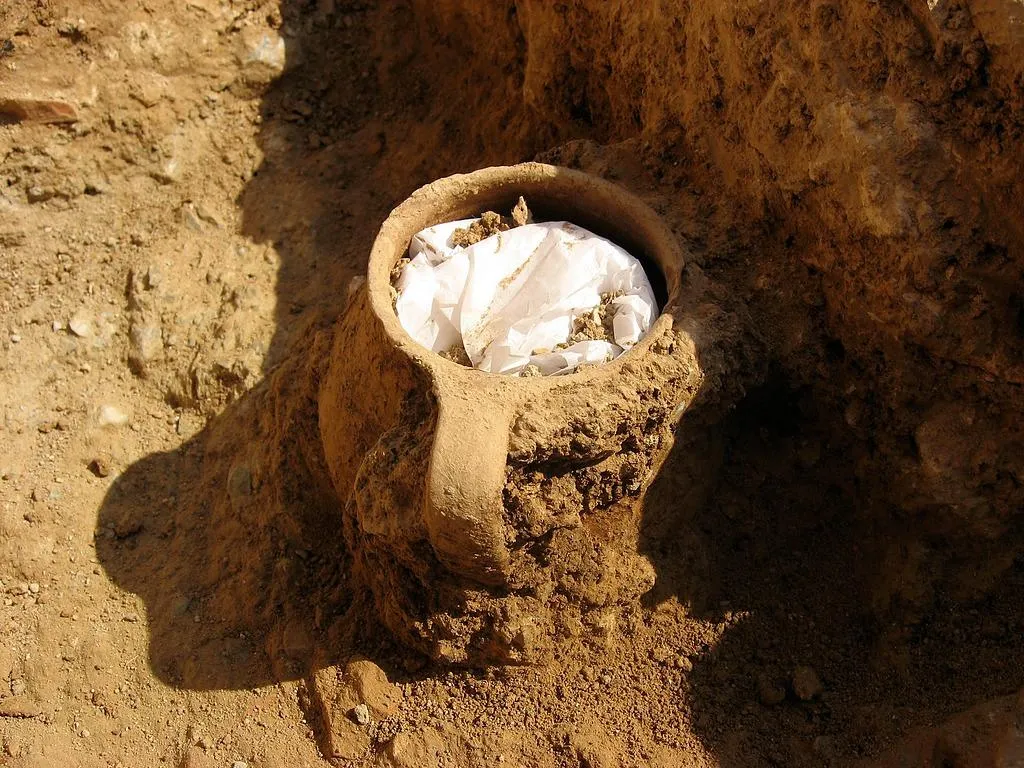Ancient Athenians Used a Jar Filled With Chicken Bones to Curse Their Enemies
The object’s owners inscribed the names of at least 55 intended victims on its surface
:focal(472x458:473x459)/https://tf-cmsv2-smithsonianmag-media.s3.amazonaws.com/filer/15/f0/15f0c80c-bdd0-40b6-9212-d6234266206d/image.jpeg)
Today, chickens are perhaps most often associated with comfort foods like soup and roast dinners. In ancient Athens, however, the owners of a 2,300-year-old ceramic jar containing the remains of a dismembered chicken appear to have used the animal for something far more sinister: a ritual designed to paralyze and kill upward of 55 people.
“This was meant to be a powerful curse,” Jessica Lamont, a classics scholar at Yale University, tells CBC Radio’s Carol Off.
As Owen Jarus reports for Live Science, researchers discovered the artifact near the Athenian Agora’s Classical Commercial Building—a public space used by the Greek city-state’s ancient artisans—in 2006. When Lamont analyzed the jar, she found that it contained a coin, a large nail, and the head and lower limbs of a young chicken.
“All exterior surfaces of the [jar] were originally covered with text; it once carried over 55 inscribed names, dozens of which now survive only as scattered, floating letters or faint stylus strokes,” writes Lamont in a Hesperia journal article fittingly titled “The Curious Case of the Cursed Chicken.”
Some of the etchings form characters that may translate to “we bind.”
/https://tf-cmsv2-smithsonianmag-media.s3.amazonaws.com/filer/b2/d1/b2d114ca-1d66-4722-a1c1-7c144c6cc491/fdasfsdf.jpg)
Per Daily Sabah, the nail and chicken remains worked in tandem with the writing to enact the curse. The bird was no older than 7 months when it died—probably because the curse’s creators wanted to convey the animal’s “helplessness and inability to protect itself” to their intended victims, according to the study.
Lamont adds that nails “had an inhibiting force and symbolically immobilized or restrained the faculties of [the curse’s] victims.”
Unlike most animal bones recovered from the Agora, the chicken’s remains were not placed directly into a fire. Instead, the person or people performing the ritual positioned the jar near several sacrificial pyres, enhancing the curse’s power through the pyres’ presumed connection to the dead.
So, why did ancient Athenians use bone fragments and chicken heads to conduct such a potent spell? As Philippe Bohstrom pointed out for Haaretz in 2020, the ancient Greeks had four main reasons for cursing someone: to win a lawsuit; for business purposes, such as hexing metalsmiths or bankers involved in ill-fated transactions; to win athletic competitions; and to express love or hatred.
In this case, Lamont believes that craftspeople may have performed the ceremony ahead of an upcoming lawsuit. At the time, trials were common and “galvanized a lot of the public,” per Live Science.
“The sheer number of names makes an impending lawsuit the most likely scenario,” Lamont argues in the study. “Curse composers might cite all imaginable opponents in their maledictions, including the witnesses, families and supporters of the opposition.”
Given that archaeologists discovered the jar in an artisan building, the lawsuit could have been linked to a workplace dispute. As religion scholar John G. Gager wrote in the 1999 book Curse Tablets and Binding Spells From the Ancient World, tablets inscribed with ill wishes were frequently associated with jobs that had a high probability of mistakes and failure. Making ceramics—a task that involved high temperatures and dangerous materials—was one such hazardous occupation.
The curse could have given its creator “a leg up on the competition in court,” Lamont tells CBC Radio.
“We can certainly, you know, get a taste for the anxiety and the fear and the nervousness heading into this trial,” she adds. “… Whoever commissioned this curse probably had a lot to lose from the occasion.”
Though laypeople tend to associate ancient Greece with great writers like Homer and astute philosophers like Plato, Lamont notes that archaeologists have discovered an “abundance of evidence” for more insidious practices such as dark magic.
Curse tablets are commonly found throughout the Greco-Roman world: Last year, for instance, excavations unearthed around 30 slabs hidden at the bottom of a millennia-old well in Athens. Similar examples have turned up in Sicily and Roman Britain, among other places, according to the University of Oxford’s Center for the Study of Ancient Documents.
Lamont hopes that these discoveries help provide a more accurate picture of revered classical civilizations.
“I think this gives a much richer, kind of truer picture of the society,” she tells CBC Radio.
/https://tf-cmsv2-smithsonianmag-media.s3.amazonaws.com/accounts/headshot/Isis_Davis-Marks_thumbnail.png)
/https://tf-cmsv2-smithsonianmag-media.s3.amazonaws.com/filer/e8/9c/e89cb724-79cf-493b-b547-ed465aa2f1ee/screen_shot_2021-06-09_at_12436_pm.png)

/https://tf-cmsv2-smithsonianmag-media.s3.amazonaws.com/accounts/headshot/Isis_Davis-Marks_thumbnail.png)